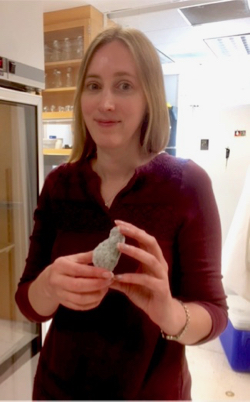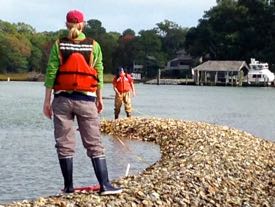Best Student Paper Awards
Each year a committee of faculty and students undertakes the difficult task of choosing the best journal articles from the many high-quality papers written by VIMS graduate students. Each paper considered is either accepted, in press, or published in a high-quality, peer-reviewed journal. The papers reflect the superb quality of the research conducted by VIMS students and the outstanding mentoring of their advisors. Papers are judged for the scope of problem, degree of challenge, magnitude of student effort, hypothesis formulation and testing, and writing style.
This year, the committee members—Donna Bilkovic, Rich Brill, Matt Kirwan, Lúcia Safi, and Ryan Carnegie—evaluated 9 papers.
PhD Category
 The winning author in the PhD category is Ann Arfken for “Denitrification potential of the eastern oyster microbiome using a 16S ribosomal RNA gene-based metabolic inference approach.” Her paper appeared in PLOS One and was co-authored by B.K. Song, Jeff Bowman, and Michael Piehler.
The winning author in the PhD category is Ann Arfken for “Denitrification potential of the eastern oyster microbiome using a 16S ribosomal RNA gene-based metabolic inference approach.” Her paper appeared in PLOS One and was co-authored by B.K. Song, Jeff Bowman, and Michael Piehler.
 In her paper, Ann used a novel bioinformatic approach to identify and quantify denitrifying bacteria within oyster guts and shells. Her work shows that the shell’s unique bacterial community has a greater potential to remove nitrogen from surrounding waters than the microbial communities that inhabit oyster-reef sediments. Removal of excess nitrogen is crucial to improved water quality in Chesapeake Bay and other coastal waters worldwide.
In her paper, Ann used a novel bioinformatic approach to identify and quantify denitrifying bacteria within oyster guts and shells. Her work shows that the shell’s unique bacterial community has a greater potential to remove nitrogen from surrounding waters than the microbial communities that inhabit oyster-reef sediments. Removal of excess nitrogen is crucial to improved water quality in Chesapeake Bay and other coastal waters worldwide.
Master's Category
 This year’s choice for the best paper by a Master’s student goes to Melissa Karp for “Faunal communities on restored oyster reefs: Effects of habitat complexity and environmental conditions.” Her paper appeared in Marine Ecology Progress Series and was co-authored by Rochelle Seitz and Mary Fabrizio.
This year’s choice for the best paper by a Master’s student goes to Melissa Karp for “Faunal communities on restored oyster reefs: Effects of habitat complexity and environmental conditions.” Her paper appeared in Marine Ecology Progress Series and was co-authored by Rochelle Seitz and Mary Fabrizio.
Melissa’s paper—the main focus of her Master’s work—presented results of a wide-ranging field study that covered 16 oyster reefs across 4 Chesapeake Bay tributaries over 3 years. The work is a valuable contribution to shellfish restoration science, as it highlights the value of oyster-reef habitat for other fauna and demonstrates the optimal environmental conditions necessary for maximum density and diversity of benthic communities on oyster reefs.

